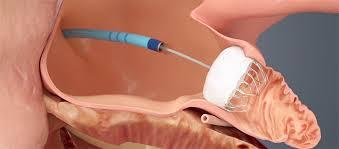Atrial Fibrillation Device Market Development: Innovations and Strategic Growth
The atrial fibrillation device market is undergoing a transformative phase, fueled by advancements in medical technology, increasing patient awareness, and strategic industry collaborations. Atrial fibrillation, a common type of cardiac arrhythmia, affects millions globally and can lead to severe health complications like stroke and heart failure if not managed effectively. As demand for efficient and minimally invasive treatment options rises, the market for devices catering to AF diagnosis, monitoring, and treatment is seeing dynamic development across multiple fronts.

Evolution of Atrial Fibrillation Management
Traditionally, AF was managed primarily through pharmaceuticals, including anti-arrhythmic drugs and anticoagulants. However, limitations such as drug resistance, side effects, and long-term ineffectiveness led to the emergence of device-based solutions. The development of catheter ablation systems, implantable monitors, and wearable diagnostic devices has revolutionized how AF is detected and treated.
In recent years, the focus has shifted toward integrated and personalized solutions. New device models not only offer precise arrhythmia control but also enable remote patient monitoring, early diagnosis, and real-time data sharing with healthcare providers.
Key Developments in AF Device Technology
1. Catheter Ablation Systems
Catheter ablation is a cornerstone in AF treatment, particularly for patients with persistent or drug-refractory AF. Recent developments include:
-
Pulsed Field Ablation (PFA): A non-thermal technique that uses high-voltage electrical pulses to destroy abnormal heart tissue with greater precision and reduced risk to surrounding tissues.
-
Cryoablation: Uses extremely cold temperatures to ablate targeted areas, offering a safer alternative with shorter procedure times.
-
3D Mapping and Navigation Systems: These systems provide real-time imaging and enhanced accuracy, reducing the margin for error during ablation procedures.
These advancements have significantly improved procedural safety, efficacy, and outcomes, prompting greater adoption in hospitals and cardiac centers.
2. Implantable and Wearable Monitoring Devices
Monitoring devices have seen rapid development, with innovations focusing on miniaturization, accuracy, and connectivity. Examples include:
-
Implantable Loop Recorders (ILRs): Provide continuous ECG monitoring for up to three years, enabling detection of asymptomatic or intermittent AF episodes.
-
Smartwatches and Wearable ECG Monitors: Devices like Apple Watch and AliveCor’s KardiaMobile have democratized access to AF screening, especially for patients in remote or under-resourced areas.
-
Patch-Based ECG Monitors: These offer non-invasive, long-term monitoring capabilities and are often integrated with mobile apps for instant data sharing.
These technologies are central to shifting AF care from hospitals to home-based models.
3. Artificial Intelligence and Machine Learning
AI is increasingly being integrated into AF devices for predictive diagnostics, risk stratification, and automated alert systems. AI-powered ECG analysis can identify early signs of AF with higher sensitivity than conventional methods. Machine learning also aids in tailoring treatment plans based on patient history and device-collected data.
Strategic Collaborations and Industry Investments
Market development has also been driven by collaborations between medtech companies, hospitals, and academic institutions. Partnerships have accelerated clinical trials, facilitated technology transfer, and enhanced global reach. Major players like Medtronic, Abbott Laboratories, Boston Scientific, and Johnson & Johnson (via Biosense Webster) are investing heavily in R&D and mergers to expand their product portfolios.
Startups and smaller players are also contributing by introducing novel technologies, especially in the field of digital health and wearable monitoring. Venture capital and government grants are enabling innovation in both developed and emerging markets.
Regulatory and Reimbursement Support
Development in the AF device market has benefited from evolving regulatory frameworks and favorable reimbursement policies. In the United States, the FDA’s expedited review pathways for breakthrough devices have encouraged faster market entry. In Europe and parts of Asia, public healthcare systems are increasingly covering the costs of ablation procedures and monitoring devices.
These policy-level developments are instrumental in increasing patient access and encouraging healthcare providers to adopt cutting-edge technologies.
Market Expansion in Emerging Economies
Another significant aspect of market development is the geographic expansion into emerging economies. Countries like India, China, Brazil, and South Africa are experiencing a rising burden of cardiovascular diseases and are actively investing in cardiac care infrastructure.
Medical tourism, especially for AF ablation procedures, is growing in these regions due to lower costs and the availability of skilled professionals. This trend opens new revenue streams for global device manufacturers and fosters local innovation.
Challenges and Future Directions
Despite positive developments, the market faces several challenges:
-
High Cost of Devices: Many AF devices remain expensive, limiting their reach in low-income settings.
-
Limited Trained Professionals: The success of advanced procedures like catheter ablation depends on skilled electrophysiologists, who are in short supply globally.
-
Data Privacy Concerns: As remote monitoring becomes more common, securing patient data remains a key issue.
Moving forward, the focus will likely shift toward integrated care models, combining telemedicine, AI, and wearable tech. Manufacturers will need to prioritize affordability and interoperability to make their products widely accessible.
Conclusion
The atrial fibrillation device market is undergoing rapid development, characterized by technological innovation, strategic investments, and global expansion. These advancements are not only transforming the clinical management of AF but are also setting new benchmarks in patient-centric care. With ongoing innovation and cross-industry collaboration, the AF device market is well-positioned for sustained growth and continued improvements in cardiovascular outcomes.
- Art
- Causes
- Crafts
- Dance
- Drinks
- Film
- Fitness
- Food
- Games
- Gardening
- Health
- Home
- Literature
- Music
- Networking
- Other
- Party
- Religion
- Shopping
- Sports
- Theater
- Wellness


